|
The
 News
News
Dedicated to Austrian-Hungarian Burgenland Family History |
THE BURGENLAND BUNCH NEWS - No. 249
November 30, 2014, © 2014 by The Burgenland Bunch
All rights reserved. Permission to copy excerpts granted if credit is provided.
Editor: Thomas Steichen (email:
tj.steichen@comcast.net)
Archives at: BB Newsletter Index
Our 18th Year. The Burgenland Bunch Newsletter is issued monthly online. It was founded by
Gerald Berghold (who retired Summer 2008 and died in August 2008).
|
Current Status Of The BB:
* Members: 2294 * Surname Entries: 7514 * Query Board Entries: 5395 * Staff Members: 17
|
This newsletter concerns:
1) THE PRESIDENT'S CORNER
2) CIS- VERSUS TRANS- LEITHA
3) BURGENLAND POPULATION DATA
4) MEMOIR OF RAYMOND BUBICK (Part 1)
5) WELCOME TO NEW MEMBER
6) HISTORICAL BB NEWSLETTER ARTICLES:
- BREITENBRUNN (from Albert Schuch)
7) ETHNIC EVENTS
8) BURGENLAND EMIGRANT OBITUARIES (courtesy of Bob Strauch)
|
1) THE PRESIDENT'S CORNER (by Tom Steichen)
 Concerning
this newsletter, after the bits and pieces here in my "Corner," our first full-length article,
Article 2, responds to (and expands on) a question concerning whether a particular village was
in Cisleitha Versus Transleitha. That labeling distinction affected far more than
just the Burgenland region! Concerning
this newsletter, after the bits and pieces here in my "Corner," our first full-length article,
Article 2, responds to (and expands on) a question concerning whether a particular village was
in Cisleitha Versus Transleitha. That labeling distinction affected far more than
just the Burgenland region!
Article 3 gives me the opportunity to present some interesting Burgenland Population Data
and the statistics, graphs and charts generated from it... but then interesting is in the
eye of the beholder and I am a retired statistician!
Article 4 introduces the Memoir of Raymond Bubick, who died in October. Born in
South Bend, IN, in 1933, Ray was a child of between-the-wars Burgenland emigrants. Perhaps his
story will help you understand better those in your family who may have had similar experiences.
Article 5 gives a Welcome To A New Member, though it also serves an additional
purpose too...
The remaining articles are our standard sections: Historical Newsletter
Articles, and the Ethnic Events and Emigrant Obituaries sections.

St. Louis Gathering of Burgenländer and Descendants: Theresa (Terry) McWilliams,
the BB's St. Louis Research staff member, wrote about last month's gathering and provided
a group photo:
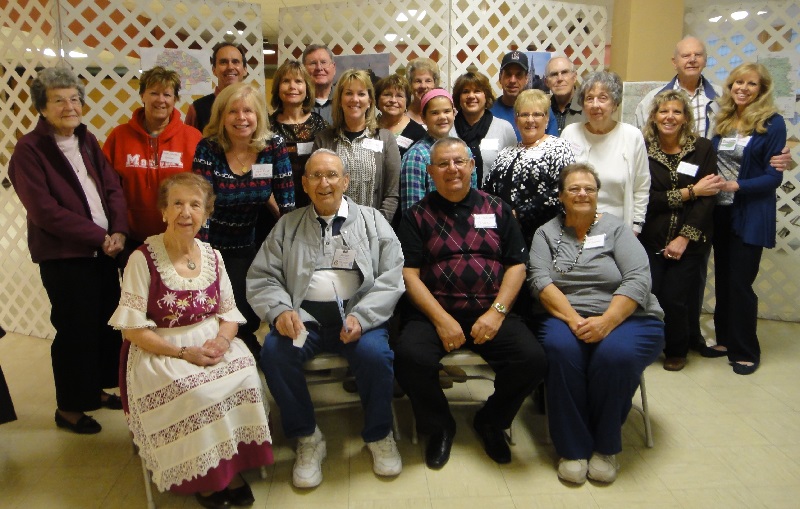 "It
has been a while since the St. Louis contingent of Burgenländers got together, but they did
just that on November 2nd. Around 25 folks showed up, some who are members of the BB, others
who heard about the gathering by word of mouth and through church bulletins. It was a
wonderful afternoon of making connections with fellow Burgenland descendants. There was food -
Austrian, Hungarian, American, German, and liquid refreshments from the Burgenland vineyards.
People brought old photos of unknowns that some others were able to identify. Some discovered
the BB and various websites that will help them with their ancestry searches. Several of the
folks already had connections outside of their heritage and discovered this one for the first
time. It was a most enjoyable gathering and we look forward to future events!" "It
has been a while since the St. Louis contingent of Burgenländers got together, but they did
just that on November 2nd. Around 25 folks showed up, some who are members of the BB, others
who heard about the gathering by word of mouth and through church bulletins. It was a
wonderful afternoon of making connections with fellow Burgenland descendants. There was food -
Austrian, Hungarian, American, German, and liquid refreshments from the Burgenland vineyards.
People brought old photos of unknowns that some others were able to identify. Some discovered
the BB and various websites that will help them with their ancestry searches. Several of the
folks already had connections outside of their heritage and discovered this one for the first
time. It was a most enjoyable gathering and we look forward to future events!"
We thank Terry for organizing the event and providing this report!

Request for Information, Frank and Gösi Families: Robert Gösi writes:
I am wondering if you can help me. I have been looking into my family name and researching
my family tree for many, many years. I believe my ancestors were Graf Frank von
Lutzmannsburg and/or Benedict Gös de Gösfalv / Benedict von Gösvalva. My
surname is Gösi and I believe my family come from the Sári Branch of the Gös
family. My father was born in a village (Pusztasomorja, in Hungary beside the Austrian border
near Andau) that is very very close (50 km or so from Lutzmannsburg and about 20 km from
Breitenbrunn) to some of the Frankó/Gös estates.
I am trying to find out as much about the family as possible but am finding conflicting
historical accounts both on the Hungarian side and the Austrian. Like, the Austrian records
refer to the Franks as Graf but the Hungarian documents only list them as nobles
without rank, and so on. And that both Frank’s and Gös’s had a common ancestor
in Gottfried and Albrecht Rittern. I also understand that the patent of
nobility and the donation letter from Geza II of Lutzmannsburg is in Austria.
I am particularly interested in the Gös side, being that my name is Gösi, and if
a Coat of Arms was ever recorded for the Gös family that came from Sár. I am
also keen on any information you have about the family between 1476-1708. They seem to
disappear. It is written that the Gös line died out... but that can’t be as I myself am
a Gösi. In my father's village, the records go back only to 1708, due to the village
being burnt down by the Turkish. From 1708, there are records of many, many Gösi in the
village.
I would be very grateful for any information you have. Regards, Robert Gösi
Editor: I was able to point to a few resources on the web that are consistent with
what Robert reports, however, I was unable to fill in any of the missing family history from the
15 and 1600s. I did, however, offer to publish Robert's request for information, which you see
above. If you know of these families and can provide information, especially pre-1700
information, Robert would be grateful. Let me know and I'll pass Robert's email address to you.

Follow-up to "1989 Burgenland Bank Advertisement": Klaus Gerger
wrote to say (in part): I like your article about the Bank ad. It just says 'bring your
money to us if you want to hide it.' The statement about banking secrecy was true until
recently changed under pressure by the EU. There are no anonymous accounts anymore and, on
request of foreign financial authorities, (banking) data of non-residents are submitted for a
court decision now and automatically from 2017. see
austria-to-end-tax-secrecy.htm.

I pulled the cited May 2013 article and found it was from OECD (Organization for
Economic Co-operation and Development). It indicated that Austria was among 12 countries that
had recently signed, or committed to sign, the OECD’s Multilateral Convention on Mutual
Administrative Assistance in Tax Matters. In addition, another 6 countries had previously
ratified the Convention, an international effort to crack down on tax offenders. “This
is a historic moment for the Convention and another winning round in the fight against tax
cheats,” said OECD Secretary-General Angel Gurría during the signing ceremony. The
Convention provides for spontaneous exchange of information, simultaneous tax examinations
and assistance in tax collection, which is a tool for governments to fight offshore tax evasion.
As of May 2013, 53 countries were signers.
So it appears that my implication, that the banking services offered in the 1989 ad would not be
allowed today, was correct... but just barely so!
As background, OECD was the successor to the Organization for European Economic Co-operation
(OEEC), which was formed in 1948 to administer aid from the Marshall Plan for the reconstruction
of Europe after World War II. By the end of the 1950s, the job of rebuilding Europe was
effectively done and OEEC no longer needed, but some leading countries felt it could be adapted
to fulfill a more global mission. Following the 1957 Rome Treaties to launch the
European Economic Community, OEDC was chartered and officially superseded OEEC in September
1961.

Second Follow-up to "A Double Blast From the Past": In the August 2014 Newsletter
(# 246), we published material from Robert Fahringer concerning members of the Fiedler family.
The second included photo, taken at Fiedler's Cafe, stirred some questions, so we ran a
follow-up on it in Newsletter # 247.
Now, Louise Yost Fielding writes to say (in part) that "I knew the man second
from the left on the photo [of the double quartet, # 2, see below]. I believe it is Charles
Gibiser, my great uncle, that lived just around the corner from us on Oak St. Charles married my
grandfather’s sister, Theresia Yost. I was able to locate Charles’ granddaughter, Margo Gibiser.
She confirmed that it was her grandfather. I am wondering if any of the readers might know other
men on the photo? I was born after my grandfather, John Yost, Sr., died [ in 1945] so I don’t
have any photos of him. I am curious to know if he might be on that photo, possibly next to
Charles."
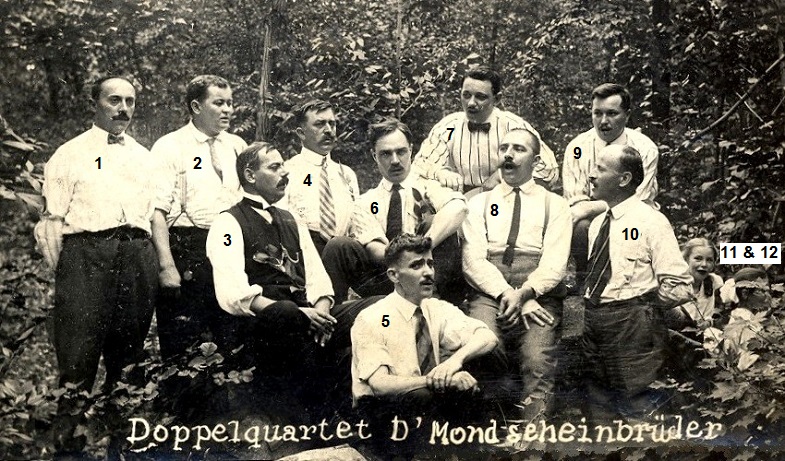
As in the first follow-up, I personally could not identify any of the individuals in the
questioned picture (well, other than John Fielder (# 10), who Bob Fahringer identified in his
original message). I did, however, again inquire of Bob, who said "The only other names that
I have for the photo were given to me by my Aunt Erna (Fiedler) Wiesner, the youngest of John
Fiedler's children. She only gave me three last names: Gibiser, Golatz, & Wallitsch." Bob
added one more name in a second message, Wirth, and noted that "Gibiser is under the
2nd from the left."
This seems additional confirmation that #2 is, indeed, Charles Gibiser. Bob also said, per his
great aunt, that #1 is a Wallitsch and #4 is a Wirth; Golatz she could not place. However,
Louise's question remains unanswered. Thus we turn to you, faithful readers, asking for
assistance in (fully) identifying the quartet members... oh, and while we are at it, in
identifying the two little imps on the far right who "photo-bombed" the quartet long before
"photo-bombing" became a defined activity!
Bob tells me that his best guess for the year of the photo is 1913-1915. As for other
information, we know that the Doppelquartet was associated with the Allentown
Turner-Liederkranz, so one would assume most of the singers are from the Allentown, PA,
area.
Interestingly, Bob has another picture seemingly taken about the same time and with a similar
location... but this is of a group of women and young girls:
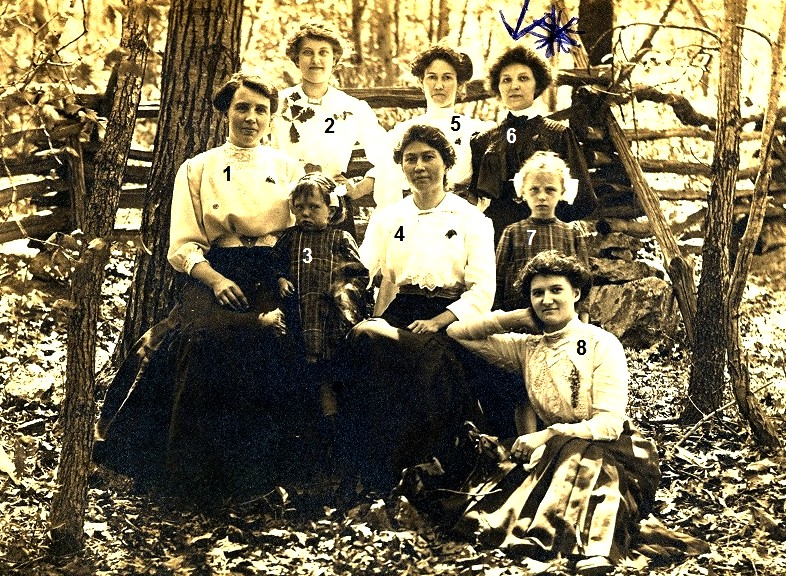
Bob notes that the lady with the arrow and asterisk (#6) is Teresa (Deutsch) Fiedler, John
Fielder's second wife... but the rest... well, perhaps you know.
Thus, my requests to the readership:
· Who are the unidentified men in the double quartet (and the girls
in the same photo)?
· Who are the unidentified women and girls in the second photo?
· (bonus question) Where were the pictures taken?
Please write to me at
tj.steichen@comcast.net, using the #'s on the pictures to indicate which person you refer
to. Given the gender difference, I should have no trouble in knowing which picture a number
applies to!

WWW.GENTEAM.EU Update: Felix Gundacker provided an update on their membership and
databases. There are now 26,000 registered users and ~11 million database entries. Access is
free but registration and a password are required.
Database Updates/Additions:
1. Diocese Passau: ~140,000 new entries, 2.3 million online (~440,000 are
marriages and are complete, ~1.1 million are baptisms, remainder are deaths)
2. Citizen Rolls of the Bratislava/Preßburg, 1630–1871 (New): ~10,300 entries;
contain surname, given name, profession, city of origin, confession and age.
3. Marriage Index for Vienna, 1542–~1860: ~4,000 new entries, over 846,000 online
4. Baptismal Index for Vienna, 1585–1900: ~80,000 new, 630,000 online
5. Catholic Register Indices: ~160,000 entries added from Lower and Upper Austria,
Burgenland, Bohemia and Moravia; Burgenland data was for Lockenhaus.
6. Jewish Familiants in Prague, to 1848 (New)
7. Jewish Marriages of Prague, 1784-1804 (New)

Additional Genealogical Resources: Margaret Kaiser recently pointed out two
additional sources for genealogical and family data. The first is the beta website of
GenealogyIndexer.com at, appropriately,
http://genealogyindexer.org/, which describes itself with text:
Search 463,000 pages of historical directories (business, address, telephone, etc.,
primarily from Central and Eastern Europe), 28,000 pages of 64 yizkor books (memorials to
Jewish communities destroyed during the Holocaust), 32,000 pages of Polish and Russian
military documents (lists of officers, casualties, etc.), 40,000 pages of community and
personal histories, and 23,000 pages of Polish secondary school annual reports and other
school sources. More genealogical resources are being added daily.
They also note that most search results link directly to the corresponding scanned page
images, which often require the .DjVu plugin for your web browser. I've not tested
this plugin (link for download given on the site) but I did a few searches within the OCR'd
(optical character recognition) data indexes... they were quick and display useful results,
however, not much in these pages apply to Burgenland. Nonetheless, the site may be of use to you
if you have wider interest in Central and Eastern Europe, or if the additional resources they
plan to add eventually cover our area.

The other resource is the list of Repositories of Primary Sources at the
University of Idaho (which, unfortunately, will no longer be updated after the end of the year).
The main index is at
http://webpages.uidaho.edu/special-collections/Other.Repositories.html and claims it is:
A listing of over 5000 websites describing holdings of manuscripts, archives, rare
books, historical photographs, and other primary sources for the research scholar.
This does not get you access to these resources but can point you to where things are,
assuming you wish to pursue such things further.

 Update
on book "The Burgenländer Emigration to America": As I will do for a while, here is this
month's update on purchases of the English issue of the 3rd edition of Dr. Walter Dujmovits'
book “Die Amerika-Wanderung Der Burgenländer.” Update
on book "The Burgenländer Emigration to America": As I will do for a while, here is this
month's update on purchases of the English issue of the 3rd edition of Dr. Walter Dujmovits'
book “Die Amerika-Wanderung Der Burgenländer.”
As of November 28, 735 copies had been purchased and the book rank reached 422, a new low (which
is good, as it means only 421 active books on Lulu have sold more).
The book is available for online purchase at a list price of $7.41,
plus tax & shipping. See the BB homepage for a link to the
information / ordering page and for any current discounts. For those of you thinking about
Christmas stocking stuffers, there is currently a 35% discount offer (runnng through December 2)
for those who have a Lulu account and are logged in ("guest" checkouts do not work): but
checkout code SAVE35 is good for only one checkout per account. Establishing a
Lulu account is free, easy and allows tracking of your order, so I do recommend that approach!

Burgenland Recipes: This one comes via Willi Schmidt, who says, "I may have
doctored up the English a little bit, but the writing is my mother’s." If you know Willi's
history (previously reported in the BB newsletters), you know that he, his mother Martha and his
other family members were deported after WW-II in 1946 from Pernau, Hungary (a Burgenland border
village). Martha passed away in 2008... but her recipe survives. However, do read her final
words at the end of this recipe! (With that thought in mind, a recipe for a non-yeast version of
Kletzenbrot can be found in Newsletter 182! And other versions can be found with a web
search.)
KLETZENBROT (from Martha Meltsch Schmidt)
(Fruit Bread) two loaves
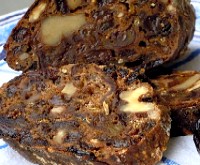 5½
c. flour
2 packages of dry yeast 5½
c. flour
2 packages of dry yeast
1½ c. dried prunes, cooked day before in red wine
1¼ c. dried figs, cut up 1¼ c. dried apricots, cut up
1½ c. dried pears, cut up 1¼ c. golden raisins
2 c. chopped walnuts ¼ c. sugar
½ tsp salt
¼ tsp anise seed
¼ tsp caraway seed ¼ tsp ground cloves
* use spices to your taste; * everything room temperature
- mix dried fruit and walnuts; combine flour, sugar, salt and spices; prepare yeast per
directions on package; add yeast mixture to flour mix; add dried fruit and nuts; add as much red
wine and water to make dough moist; knead well
- place in greased pan for first rising; cover and let rise for an hour
- divide dough into two loaves; place in 8" dia. greased layer cake pans; cover and let rise for
an hour
- bake at 350º for one hour; test with toothpick
"This is my recipe. You make yours. Good luck!"

Genealogical Cartoon of the Month:

|
2) CIS- VERSUS TRANS- LEITHA
Robert Chapman wrote to me with a question about the Leitha River. He was in
Lébény, Hungary, after two days in Gols, Burgenland, both visits as part of a European trip in
early October. He commented that he had driven to Gattendorf (Burgenland) "to view and
photograph the Leitha River. So I have confirmed that Gols was not Transleithana. However, I
remain uncertain about Lébény, Hungary. With your vast knowledge of the area, might you be able
to tell me on which side of the Leitha is Lébény situated?"
I replied (in part): That’s an interesting question, Bob. The Leitha is
relatively short, starting 6 or 7 miles S-SW of Weiner Neustadt, becoming part of the border
between the Lower Austria and Burgenland from near Neufeld an der Leitha until just beyond
Leithaprodersdorf, and then again between Bruck an der Leitha and Gattendorf. It then cuts SE
across the tip of Burgenland and goes into Hungary just northeast of Nickelsdorf, where it
becomes known as the Latja River. From there it flows southeast to Mosonmagyaróvár, where
it terminates and empties into the Moson arm of the Danube River. Lébény is another 10-15 miles
further S-SE of Mosonmagyaróvár.
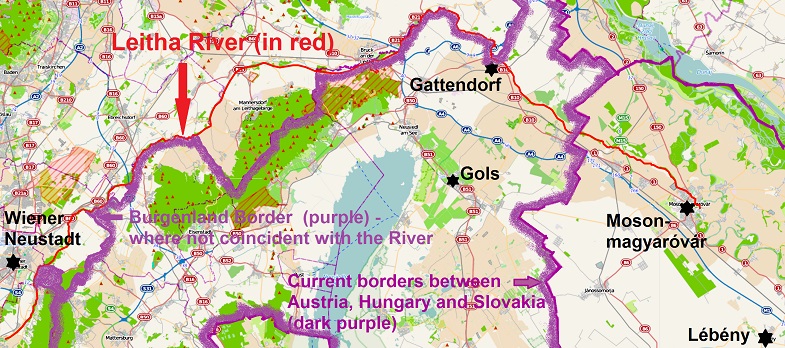
Now, if you consider the Leitha mostly as a diagonal arc from SW to NE (i.e., ignoring
its further run to the SE beyond Gattendorf) it is a crude line dividing Vienna and old Austria
(to its NW) and Budapest and old Hungary (to its SE), which is the way geographers think of it
when speaking of Cisleitha (Austria) versus Transleitha (Hungary). In this sense,
Lébény, being definitely to the SE of the arc, is “Beyond the Leitha” (Trans)
rather than “On this side of the Leitha” (Cis), at least from a Viennese
perspective.
By the way, by that same commonly-accepted notation, Gols is also Transleitha (as it was
part of Hungary until 1921 and is SE of the arc). You must have misspoke in your statement about
Gols.
Bob replied (in part): For what it’s worth, I spent one night each in Györ and
Mosonmagyaróvár. My hotel in Mosonmagyaróvár, the Engler (quaint little place), is
located on the bank of the “Little Danube”. Curious that Gols is Transleitha
since the town is definitely west of the Leitha River. The river is even east of the M1.
I replied: The problem is that the Leitha River is more like a wide
inverted U and only the upper left and top part of it was the border… but that was the part that
was nearest to Vienna so gave the Cis--Trans divide its name. Burghardt in his book “The
Political Geography of Burgenland,” says “The river became the symbol of the boundary so
that the two halves of the dual monarchy were often referred to as Trans-Leitha (Hungary), and
Cis-Leitha (Austria). The most cursory glance at the map reveals, however, that the Leitha is by
no means consistently the boundary; instead the line moves back and forth, with three departures
eastward from the stream. The Leitha carries the boundary for only three-fifths of the distance
between Neudörfl and Gattendorf. In the continuing border discord between Hungary and Lower
Austria, the Leitha was not only a symbol of the boundary, but also became a symbol of the
discord concerning the placement of the line.”
In effect, the part of the river that is in current Burgenland and in Hungary had nothing to do
with defining and naming the boundary, so you should not determine East vs. West (Trans
vs. Cis) by those portions. Only the small part that was along the “Thousand Year
Border” between Austria and Hungary (Neudörfl to Gattendorf ) is informative… so forget that
it also runs from Gattendorf to Mosonmagyarovar! Likewise, if you draw a line between Vienna and
Budapest, that line would cross the (old) border at the Leitha, thus the names.
By the way, the Leitha (Latja) dumps into the Little Danube about a
half-mile straight north of your hotel (a somewhat longer distance, though, if you follow city
streets to there, as you’ll have to work westward and then eastward around the bend in the
Little Danube).

Some follow-up comments: The concept of Cis- vs. Trans-Leitha
came into being when the Austro-Hungarian Empire became the Dual Monarchy due to
the Compromise of 1867.
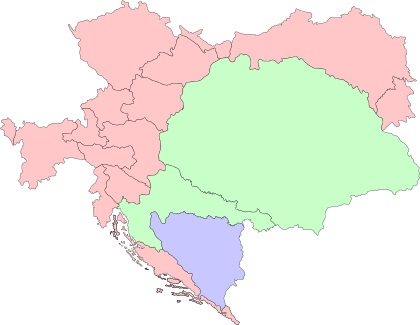
Cisleitha (shown in pink in the image to the right) was the common but unofficial
denotation for the northern and western part of Austria-Hungary, i.e., for "Die im Reichsrat
vertretenen Königreiche und Länder" ("The Kingdoms and Lands represented in the Imperial
Council"), otherwise known as Austria, with a population of about 20 million.
Transleitha (shown in green) was the term applied to the "Lands of the Holy Hungarian
Crown of St Stephen" (Hungarian: Szent István Koronájának Országai or A Magyar Szent
Korona Országai; German: Länder der Heiligen Ungarischen Stephanskrone), otherwise
known as Hungary, with a population of about 15 million.
[Aside: The blue section was known as The Condominium of Bosnia and Herzegovina
and was part of the Ottoman Empire in 1867. However, it was occupied by Austria-Hungary
in 1878 and formally annexed in 1908 and became a separate, third part of Austria-Hungary.]
For those interested in the details, the image below shows the constituent parts
of Cis- and Trans-Leitha in 1867, along with their capital cities; the
associated text provides the key to the numbered parts as well as, in square brackets [], the
successor nation(s) they are part of now:
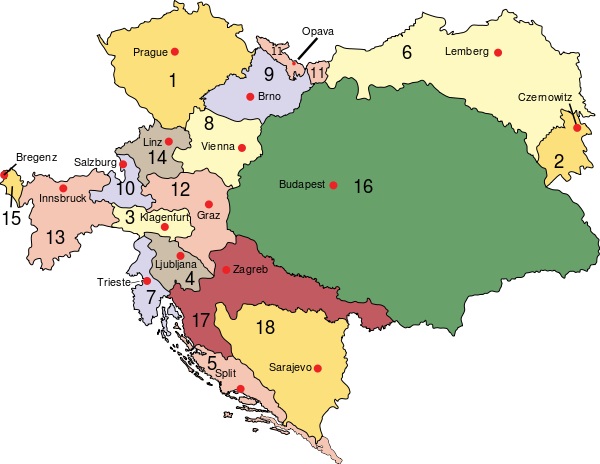 Cisleithania (Empire of Austria): 1. Bohemia [Czech Republic], 2.
Bukovina [Romania, Ukraine], 3. Carinthia [Austria, Italy, Slovenia], 4. Carniola [Slovenia], 5.
Dalmatia [Croatia], 6. Galicia [Poland, Ukraine], 7. Küstenland [Croatia, Italy, Slovenia], 8.
Lower Austria [Austria, Czech Republic], 9. Moravia [Czech Republic], 10. Salzburg [Austria],
11. Silesia [Czech Republic, Poland], 12. Styria [Austria, Slovenia], 13. Tyrol [Austria,
Italy], 14. Upper Austria [Austria], 15. Vorarlberg [Austria];
Cisleithania (Empire of Austria): 1. Bohemia [Czech Republic], 2.
Bukovina [Romania, Ukraine], 3. Carinthia [Austria, Italy, Slovenia], 4. Carniola [Slovenia], 5.
Dalmatia [Croatia], 6. Galicia [Poland, Ukraine], 7. Küstenland [Croatia, Italy, Slovenia], 8.
Lower Austria [Austria, Czech Republic], 9. Moravia [Czech Republic], 10. Salzburg [Austria],
11. Silesia [Czech Republic, Poland], 12. Styria [Austria, Slovenia], 13. Tyrol [Austria,
Italy], 14. Upper Austria [Austria], 15. Vorarlberg [Austria];
Transleithania (Kingdom of Hungary): 16. Hungary [Hungary, Romania, Slovakia,
Austria, Serbia, Ukraine, Slovenia, Poland], 17. Croatia-Slavonia [Croatia, Slovenia];
Austrian-Hungarian Condominium: 18. Bosnia and Herzegovina [Bosnia-Herzegovina].
In addition, four other entities are not shown in this map: A. Lombardy (below 15) and
B. Venetia (below 13) were part of Cisleithania until transfer to Italy in 1859 and 1866; and C.
the free city of Fiume [now Rijeka, Croatia] and D. Hungary's Militaergrenze (Military
Border) [to Croatia, Serbia and Romania in 1872] were part of Transleithania.
It should be noted that the lands that became Burgenland were part of
Transleithania, as they were part of Hungary prior to their transfer to Austrian political
control and the formation of Burgenland in 1921, which is also when its parent entity known as
Austria-Hungary was deconstructed.
It should also be noted that, when your ancestors wrote "Austria" as their place
of origin, they could have been (correctly) referring to any of the 18 numbered entities in the
above map (as well as the four entities, A-D, not on the map). Likewise, a claim of "Hungary"
could also refer to Croatia, Slavonia, the Condominium, Fiume or the pre-1872 Militaergrenze, as
well as Hungary itself. While it is feasible, it is nonetheless unlikely that "Hungary" would
have been used to refer to an entity in the Cisleitha half.
A slightly different presentation of the disposition of the Austro-Hungarian Dual Monarchy, one
with modern national boundaries, is shown below:
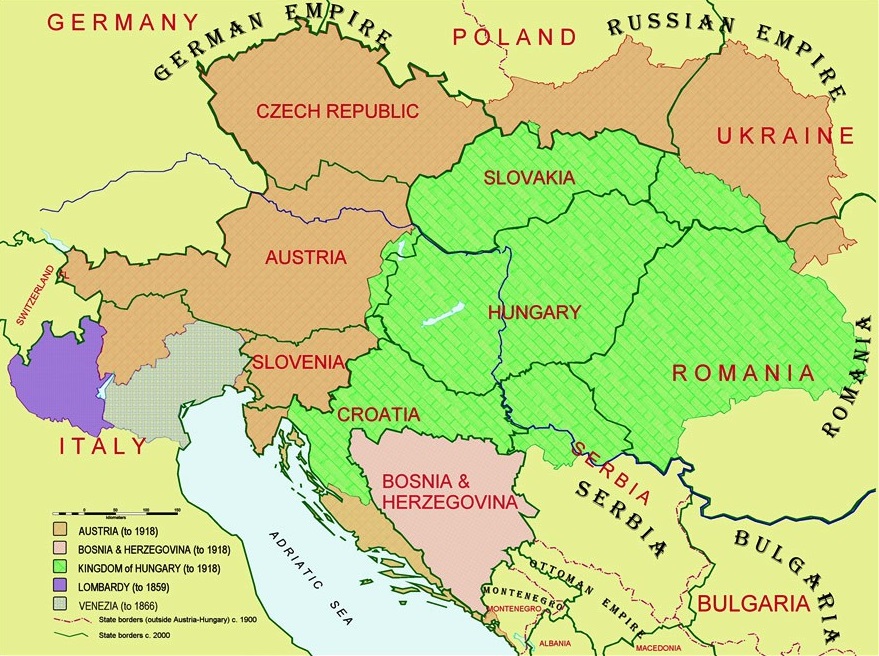
|
3) BURGENLAND POPULATION DATA
I have mentioned before that the Burgenland state government provides population statistics via
their site at www.burgenland.at. Being a statistician by
training (though now retired), I remain interested in statistical data, as I believe it, when
properly considered, provides valuable insights.
The Burgenland population statistics are one such collection of data that fascinate me (I
mentioned it previously as recently as Newsletter 246, where I compared percentages of 95+
year-olds in the US and Burgenland populations). In this article, I wish to present a few items
for your consideration from those data.
The first is for how the Burgenland population changed in year 2012 (the most
recent year available on the website). Data are presented for each independent District (Bezirk)
and Free City (Freistadt), though for my purposes I also add free cities Rust and
Eisenstadt into the Eisenstadt-Umgebung district, showing the combined numbers in italics
and a smaller font size, as I did for the separate numbers for the free cities. I've also
rearranged the districts to present them from north to south, as I believe that
arrangement helps our understanding of these data.
Population Change in 2012
| Bezirk-Freistadt |
Births |
Deaths |
Birth/Death
Balance |
Immigrants |
Emigrants |
Migration Balance |
Population Balance |
| Neusiedl am See (2) |
426 |
615 |
-189 |
2,195 |
1,536 |
659 |
470 |
| Eisenstadt-Umgebung (1) |
329
484 |
445
618 |
-116
-134 |
1,644
2,930 |
1,275
2,278 |
369
652 |
253
518 |
| Eisenstadt-Stadt |
137 |
149 |
-12 |
1,204 |
958 |
246 |
234 |
| Rust-Stadt |
18 |
24 |
-6 |
82 |
45 |
37 |
31 |
| Mattersburg (4) |
317 |
431 |
-114 |
1,480 |
1,287 |
193 |
79 |
| Oberpullendorf (5) |
267 |
503 |
-236 |
1,174 |
946 |
228 |
-8 |
| Oberwart (3) |
383 |
640 |
-257 |
1,829 |
1,636 |
193 |
-64 |
| Güssing (6) |
172 |
307 |
-135 |
1,187 |
1,097 |
90 |
-45 |
| Jennersdorf (7) |
106 |
188 |
-82 |
624 |
640 |
-16 |
-98 |
| Burgenland |
2,155 |
3,302 |
-1,147 |
11,419 |
9,420 |
1,999 |
852 |
Adapted from:
Population change by municipality 2012
The first point I'd like to draw your attention to the numbers in
parentheses in the first (leftmost) column. These are the 2012 population rankings
of the districts, with Eisenstadt-Umgebung being the largest and ranked (1) and Jennersdorf
being the smallest and ranked (7) [actual population counts are not shown]. The
only variations from the north to south ordering is that Oberwart, though south of Mattersburg
and Oberpullendorf, has a larger population than either of them, and that Eisenstadt-Umgebung,
which is (slightly) south of district Neusiedl am See, is larger in population (and is even
larger if the contained free city populations are added to the district count). (However, as the
southern border of Eisenstadt-Umgebung is north of the southern border of district Neusiedl am
See, one could easily argue about which is more "northern.")
Clearly, a major influence driving these rankings is distance from Vienna, and
Eisenstadt-Umgebung is likely, "on average," closer to Vienna than is district Neusiedl am See.
I'd also speculate that Eisenstadt-Umgebung "benefits" from having the Burgenland capital city
within its bounds as well as having good freeway access to both Vienna and Wiener Neustadt. As
for Oberwart, it had the largest population among the districts when Burgenland was formed in
1921 (more on this later).
The second point I'd like to draw your attention to is found in the
Birth/Death Balance column, shown in light grey in the center of the table. As you can
see, each district and free city had more deaths than births in 2012, leading to a combined
decrease (from these forces) in Burgenland's total population by 1,147 souls in just one year!
My guess (and that is all it is) is that this phenomenon is driven more by a declining birth
rate than an increased death rate (as this driver of population size is common among developed
nations).
The third point I'd like to draw your attention to is found in the Migration
Balance column, also shown in light grey. These numbers are the difference between
inflow (immigration) and outflow (emigration). It should be evident that this also is a
north-to-south phenomenon, with large increases in the north that get smaller as you move south,
actually turning negative for Jennersdorf. Only Oberpullendorf diverges from the trend, having a
net migration increase slightly larger than its north-south ordering would suggest.
Lastly, let's look at the last column, Population Balance. This
column combines the Birth/Death and Migration balance columns to arrive at an
overall population change for the districts. Again, there is a clear north-to-south trend, with
gains in total population in the north and decreases in the south. Only the Oberwart / Güssing
ordering fails to match the north / south sequence.
Overall, Burgenland gained 852 residents in 2012, as the migration balance of
+1,999 exceeded the birth/death balance of -1,147. These numbers serve to support Walter
Dujmovits statement about Burgenland (from "The Burgenländer Emigration to America," 2013
English Edition), that "A land of emigrants has become a land of immigrants." Migration
did not stop, but its well-trained and highly-qualified young people continue to emigrate out
while foreign immigrants arrive to fill low-paying jobs that require little training.

Earlier, I had mention that Oberwart had the largest population among the districts when
Burgenland was formed in 1921 and I promised more on this later. The graph below is also found
among the population statistics at www.burgenland.at,
though I slightly adapted it. It portrays the change in population for each Burgenland
district over the time period 1923 to 2012.
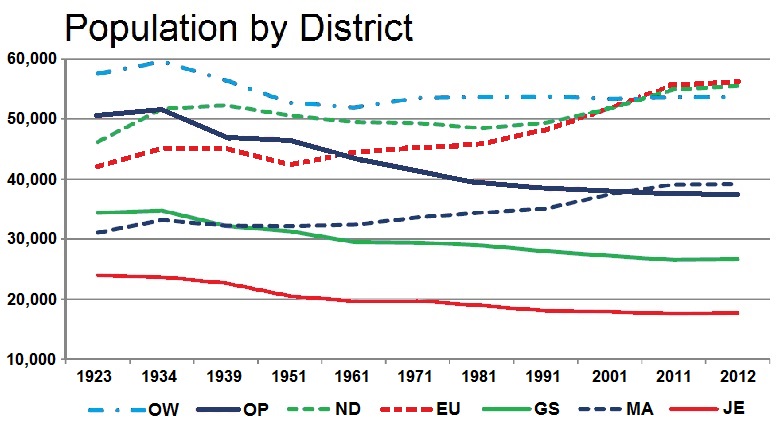
If you look closely, you will see there are three "groups" of districts. Oberwart (OW), shown by
the dash-dot-dash light blue line, is relatively unique in that its population has stayed
relatively constant since the end of WW-II. It started in 1923 with the greatest district
population and held that position until the mid-2000s, when both Neusiedl am See (ND) and
Eisenstadt-Umgebung (EU) slightly exceeded it. Neusiedl and Eisenstadt, along with Mattersburg
(MA), make up the second group and are shown with dashed lines. The districts in this
group are the three northernmost and all are increasing in population. The last group, shown in
solid lines, consist of Oberpullendorf (OP), Güssing (GS), and Jennersdorf (JE). These
are three of the four southernmost districts and all show a sustained decline in population.
Oberwart, the fourth of the southernmost districts, has also lost population compared to 1923
but, as noted above, arrested that decline after WW-II and has maintained its population since
then.
Oberpullendorf has the dubious distinction of losing the most population, declining from the
second most populous district to fifth place now. Eisenstadt-Umgebung, on the other hand, has
risen from fourth to first.
Overall, these graphic data show that the 2012 data presented in the table above
are not inconsistent with the long-term trend of population increases in the north and decreases
in the south. However, it should be clear that the declines are driven mainly by the decreased
birth rates while the growth in the north by a positive migration balance. Again, "A land of
emigrants has become a land of immigrants."

The last item I wish to show from the population statistics at
www.burgenland.at is the chart provided below:
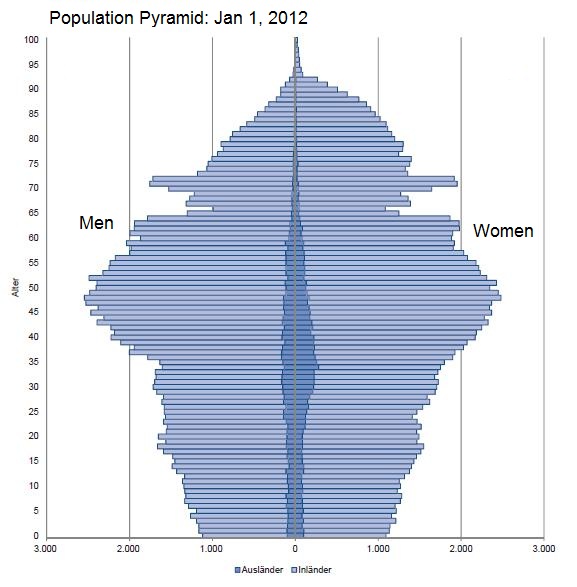
As the chart indicates, this is a "Population Pyramid," with age rising from
zero at the bottom to 100 at the top, and the bars indicating counts of men (in the left half)
and women (in the right half) at each age value. Thus we see that the largest age groups occur
around age 50 and consist of ~2500 men and ~2500 women at each age. The chart is fairly
symmetrical up to about age 35, where we see the start of a slight preponderance of women over
men. This effect becomes quite marked for those over age 75. Again, this is a common phenomenon
across the developed world.
The "pinching in" of counts for those in the 65-69 age range is, presumably, due to the effects
of WW-II, when many men died or were injured (and thus were unable to have children), and when
the war-induced poverty and Soviet occupation after the war made it difficult to justify having
children, even among those able to do so. The fact that the age groups on either side (those in
the 70-72 year-old ages and in the 64 and younger) are larger strongly suggests that this was a
real decline, as one would not expect these surrounding groups (especially the older
group) to have significantly larger counts than the middle group.
The darker blue down the center of the chart represent those born outside of Burgenland (Ausländer
/ immigrants); the lighter blue represent those born in Burgenland (Inländer). As
you can see, the Ausländern tend to be of prime working age (and they likely are
responsible for the Ausländer children shown among the youngest groups). Given the data
in the table that I showed in the first section of this article, it seems reasonable to believe
that the majority of these Ausländern are in the northern districts, where they will
serve to continue the growth in the north with their future generations.

I hope you found these data interesting and informative. If so, you can find more by
exploring the pages at www.burgenland.at under menu
sequence "Land, Politik & Verwaltung" > "Land" > "Statistik Burgenland."
|
4) MEMOIR OF RAYMOND BUBICK (Part 1)
 BB
member Kevin Krizman, currently of Umkirch, Germany, wrote to say (in part): Hi Tom,
just a quick note to let you know we lost one of our own this month. My uncle, Ray Bubick, 81,
died peacefully (if unexpectedly) at home on Oct 12, 2014. His obituary is here:
obituary/Raymond-Joseph-Bubick/Highlands-Ranch-CO. Ray was a great fan of the Burgenland
Bunch [Ed: ...and a long-time member; the earliest note from Ray I found in the newsletters
dates from July 2003, wherein he commented on a goulash recipe, noted a 2002 trip to Burgenland
and his 12 first cousins there, and invited BB members to stop by in Denver to share some
goulash!]. He dutifully and enthusiastically forwarded the newsletter to members of the
family every month (even to those of us with a separate subscription :-)). I know Ray
appreciated and enjoyed being involved with the Burgenland group; he was responsible for
infecting me with enthusiasm for Burgenland as well. BB
member Kevin Krizman, currently of Umkirch, Germany, wrote to say (in part): Hi Tom,
just a quick note to let you know we lost one of our own this month. My uncle, Ray Bubick, 81,
died peacefully (if unexpectedly) at home on Oct 12, 2014. His obituary is here:
obituary/Raymond-Joseph-Bubick/Highlands-Ranch-CO. Ray was a great fan of the Burgenland
Bunch [Ed: ...and a long-time member; the earliest note from Ray I found in the newsletters
dates from July 2003, wherein he commented on a goulash recipe, noted a 2002 trip to Burgenland
and his 12 first cousins there, and invited BB members to stop by in Denver to share some
goulash!]. He dutifully and enthusiastically forwarded the newsletter to members of the
family every month (even to those of us with a separate subscription :-)). I know Ray
appreciated and enjoyed being involved with the Burgenland group; he was responsible for
infecting me with enthusiasm for Burgenland as well.

I offered my sympathies to the family and asked if it would be okay to run a note
in this newsletter about Ray's passing. Kevin said that would be fine, and then went on to say:
"Among the things Ray Bubick left behind is a memoir (unfortunately unfinished), which
included a fairly detailed section on his Burgenland ancestry, and is a nice first person
account of growing up as the child of Burgenland immigrants."
Kevin included the text and asked if I thought it might be of interest to our readership. After
reading it through, I concluded that yes, it would be of interest but was too long for a single
article... but that it would work if I serialized it into two or three sections. So, below
is the first installment of Ray's memoir, the "Forward" and "Ancestry" sections:

MEMOIR OF RAYMOND BUBICK: FORWARD
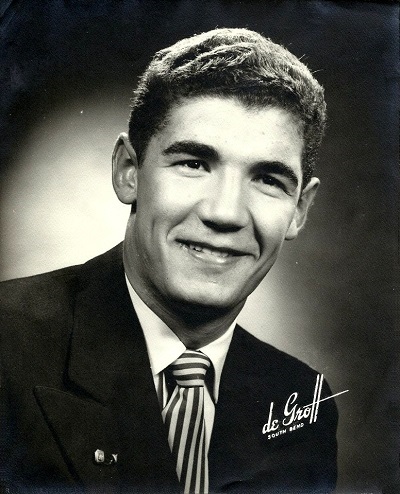 As
a young boy growing up in Northern Indiana, I often wondered about my ancestors, my heritage,
and in particular, my grandparents. All my friends and pals had grandparents, so I often asked,
why didn't I? I envied my pals; their doting grandparents always seemed to have presents for
them, always seemed to have "hugs," and always acted as surrogate parents! As
a young boy growing up in Northern Indiana, I often wondered about my ancestors, my heritage,
and in particular, my grandparents. All my friends and pals had grandparents, so I often asked,
why didn't I? I envied my pals; their doting grandparents always seemed to have presents for
them, always seemed to have "hugs," and always acted as surrogate parents!
Well, of course I did have grandparents, but I never saw them. Both my father and mother were
among the many European immigrants who came to this country in the early part of the 20th
century and left their respective families back in the "Old Country," as they often
referred to it. I believe when they left the "Old Country" my parents resolved in their minds
that, most likely, they would never see their parents again. Travel and communications back in
those days was expensive, tedious, arduous and not often repeated. I suppose I sensed this as
well, and hence resolved in my young mind that I too would never see my grandparents. As it
turned out, I never did, as both sets of my grandparents passed away in the '40s and '50s. I
don't know the dates of the passing of my paternal grandparents but, having some old pictures of
them, I know they lived to be close to 70 years in age. My maternal grandfather lived to age 72
and died in 1946, and my maternal grandmother at the age of 64, in 1944.
Consequently, I never heard the wondrous stories of my "grandpa" or "grandma" or sat upon the
knee of those wonderful people who supplemented the joyful young lives of my buddies. My father
rarely, if ever, talked about his parents. In fact, I can't remember him ever saying anything at
all. I don't know why he never did. I suppose if I had pressed him he would have talked about
them. My mother did on occasion talk about her parents. From time-to-time she referred to the
austere environment under which she was raised and described the rigorous religious upbringing
she had. As a young boy, I wasn't particularly interested in hearing the rigors of my mother's
upbringing. As I recall, my father left Austria because he sought the proverbial "better"
life that was being promised in America; and my mother came to America because she often said: "I
didn't want to grow up to be a farmer's wife."
It wasn't until my adult life, the mid 1970's, that I started to take a real interest in my
ancestry and in particular my many relatives who lived in the "Old Country," even though
I had a substantial number of relatives here in America. But, most of my relatives were in the
motherland of my parents, Austria! In 1970, my first cousin, Irene Bubits from Vienna, had
already visited me; and both travel and communications had so vastly improved that I realized
that now I could see, hear and visit my ancestors.
So why I am doing this story of my life? Believe me, it is not for any narcissistic reason. My
main reason for writing this is because I hope whoever reads this someday will read it with the
thought that I wanted to retain some "family history" and pass on to my future generations some
of the thoughts and ideas about which I often wondered as a small child, and how my life evolved
as I matured.

MEMOIR OF RAYMOND BUBICK: ANCESTRY
The Province of Burgenland in present-day eastern Austria, and the birth place of both of my
parents, has experienced the vicissitudes of history. It was part of "central" Austria during
the reign Emperor Franz Josef of the Hapsburgs in the late 19th and early 20th Century. At one
time, it was part of the ancient Croatian Empire and has changed its registry after each
significant war. Hence, the languages spoken in the Province are varied. German is now the
official language, but many still speak Serbo/Croatian (a Slavic language akin to Russian); and
many speak Hungarian, because of its proximity to the Hungarian border, which is neither a
Germanic nor Slavic language.
My father claimed he could speak German, Hungarian, Croatian, and eventually English. Croatian
was his native tongue however. My mother could also speak the same languages, although her
Hungarian was not too good. As a young girl, she too spoke primarily Croatian, and that was the
language under which I was reared for the first three years of my life. In fact, I spoke no
English until I was three years old, as we lived in a Slavic enclave my first three years. When
we moved to 1850 E. Bowman Street (South Bend) in 1936, my parents decided that little "Raymond"
should now learn English. There was no demand made by my parents or any of my relatives that
German or Croatian be spoken in the local schools under a bilingual program. They understood
that this was America, and they had to learn to speak English.
After we moved in 1936, I would speak part Croatian and part English to my pals, and at times it
was comical. I used to get kidded by my pals, so as a result I discouraged my parents from
speaking to me in Croatian. Whenever they did, I protested, "Mom, speak to me in English
only!" Slowly my proficiency in that wonderful language faded, until the time when I could
barely understand the language. To this day, I rue the decision I made to discourage its use,
and only wish my parents had persisted in keeping me proficient in the language.
My father Joseph (or Joshko in Croatian & Hungarian, and phonetically pronounced
Yoshko), was born in the village of Grossmutchen, a very small farming community in
Burgenland. My father had no middle name, as most children born there in that time did not. He
was born on March 30, 1903. His father was Stefan Bubits, and his mother's name was Karolina
Huber. I'm not sure in which order of birth he came [Ed: fifth of six], but he had
brothers Frank [Ed: b 1898], Steve [Ed: b 1899] (who I believe were older), Dennis
[Ed: b 1907] (younger, and whom I knew and loved, since he lived in the USA); and a
younger [Ed: older] brother named Louchey [Ed: Lajos, b 1901] (or Louie in
English). I am told that Louie either died at birth or shortly thereafter. My Aunt Emma (my
Uncle Dennis' wife) tells me that there was also a baby girl
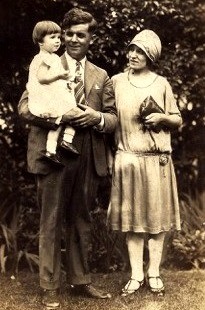 [Ed:
Maria Francisca, b 1895, d 1897] born to my grandparents, who never survived; although the
accuracy of this is in question. I'm not sure when my father arrived in the U.S., but I believe
it was in 1924 [Ed: he left Rotterdam on 16 Jan 1924 and arrived in NYC on 27 Jan 1924 on the
SS Rotterdam; going to Chicago to join uncle Anton Blazowitsch]. So, my guess is that he was
near 20 years old when he arrived. [Ed:
Maria Francisca, b 1895, d 1897] born to my grandparents, who never survived; although the
accuracy of this is in question. I'm not sure when my father arrived in the U.S., but I believe
it was in 1924 [Ed: he left Rotterdam on 16 Jan 1924 and arrived in NYC on 27 Jan 1924 on the
SS Rotterdam; going to Chicago to join uncle Anton Blazowitsch]. So, my guess is that he was
near 20 years old when he arrived.
My mother Margaret (or Marga in Croatian), also had no middle name, and was born on June
7, 1909 to Johann Fleischhaker, and Rosalia Buczolich, in another small farming community in
Burgenland, called Nikitsch. She was one of seven children, three of whom eventually settled in
the USA. Besides my mother, her brothers John (Johann) and Joe (Joshko) moved to America.
My mother came to America with her brother Joe. They entered the United States on July 4, 1930,
on the ship, Hamburg. I still have the original two wicker suitcases with which they both
traveled. (I’ve given the suitcases to son, Kevin). My mother told me they had to stay an
additional day on the ship because of the July 4th celebration.
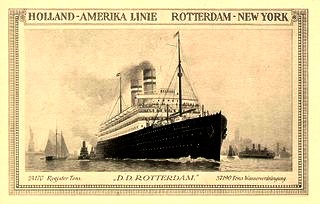 As
with all immigrants who entered the US, they processed through the central processing facility
on Ellis Island. I'm sure their names (as well as that of my father) are recorded somewhere in
the archives of Ellis Island. As
with all immigrants who entered the US, they processed through the central processing facility
on Ellis Island. I'm sure their names (as well as that of my father) are recorded somewhere in
the archives of Ellis Island.
[I have often marveled at the courage and fortitude it must have taken my parents to forsake
their parents, families and friends and move to a strange land; not knowing the language, not
having a job; and possessing only a burning desire to succeed by taking advantage of the
opportunities afforded in America. I wonder how many people would do that today!]
My mother’s four other siblings, stayed in Nikitsch. She had one other brother, Anton, and three
sisters, Elizabeth, Maria (Mariza) and Anka.
The children of my father's brothers are as follows:
| Brother |
Children |
Grandchildren |
| Frank Bubits |
Irene Bubits
never married, taught music in Vienna, retired |
|
| Stefan Bubits |
Stefan Bubits
never married, lives in Grossmutschen |
|
Anna Abrecht
lives in Switzerland
Husband: Freddie |
Stefan, Mark, & Annette |
Dennis Bubick
(died 1982)
married Emma (died 2002) |
William, now deceased |
Bill Jr. in California, now deceased |
The children of my mother's brothers' and sisters' are as follows:
| Brother / Sister |
Children |
Grandchildren |
John Fleischaker,
married to Mary |
Arlene, lives in South Bend, widow of Bill Cerney |
|
| Joseph Fleischaker, married to Mary |
Joe Jr., a lawyer, lives in Chicago, has a half sister, Alice Owen |
Alice, daughter of Mary from previous marriage |
| Anton Fleischaker |
Anna Jordanich, married to Martin, lives in Nikitsch |
Monika, Franz in Nikitsch, and a son who was murdered in Greece |
| Raiza Balogh, married to Peter, lives in Nikitsch |
Richard and Petra |
| Johann Fleischaker, owns a winery in Nikitsch |
Vicent, Maria and Gabbriella |
Elizabeth (Lisa),
eldest of mother's siblings |
Maria Jordanich, lives in Nikitsch |
| Franz, deceased |
|
| Felix |
|
Anka,
married name is unknown |
Paula Drimmel, married to Joe, lives in Minihof |
MaryAnne and Monika |
| Hilde Palatin, married to Hans, lives in Vienna |
Eveline and Donnela |
Maritze (Maria) Prikosovits,
youngest of mother's siblings |
Felix, insurance broker in Vienna |
|
| Johan (Yonchie), lives in Minihof |
|
| Hermann, computer programmer, lives in Vienna |
Hermann, married to Karin, children: Rajko and Vanja |
Although my father's original family name was BUBITS, the name has taken on a few
derivatives over the years. BUBITS I believe, is the German derivative, and is the name
my cousins Irene, and Stefan have carried over. My father used the BUBICH spelling, which
I believe is the Slavic derivative and which he brought to the States. There are many BUBICHs
in Burgenland. My uncle Dennis used the BUBICK spelling when he came to America. The
'ICH' in the German language has a hard "EK" pronunciation, thus the derivation of
the BUBICK spelling. My birth certificate has the "H" ending. When I was a senior
at Notre Dame, I had the name officially changed to BUBICK.
During a trip to Vienna in 1993, I noticed that there were 12 or 15 BUBITS in the Vienna phone
directory. My aunt Emma believes they are all related to us and are descendants of the BUBITS
clan from Burgenland. In my travels around the USA, I've noticed very few BUBICKs: one in
Chicago, but I'm not sure they are related in any way. The name BUBECK is actually quite
common through out the states but, to the best of my knowledge, has no relationship to my
relatives. If one goes to the computer Internet, and searches for BUBICKs, one can find
several BUBICKs in New York, Pennsylvania and other places.
My mother's family name comes from the German word Fleish (meat) and is literally
interpreted as "meat-cutter." In reality, I don't believe any of the Fleischhakers were,
in fact, butchers, however my Uncle Frank Bubits (Irene's father), was indeed a professional
butcher in Vienna.
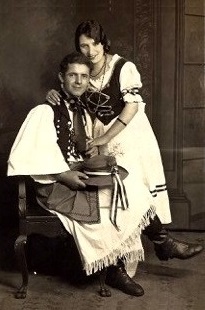 Strange
as it seems, my father and mother did not know each other in Burgenland, even though they were
reared in villages not more than a few miles apart. They did not meet until they did so in South
Bend. My father had been married before he married my mother. He was married to a woman named
Agnes, who died rather suddenly in 1929 and left my father as a widower with my half sister
Lillian [Ed: Lillian was mother to Kevin Krizman, who shared Ray's memoir with us].
Lillian was seven years older than I. There is a little mystery (if that's the right word)
behind Agnes' death—not that she was mysteriously murdered or anything like that—but, from my
Aunt Emma, I got the impression that Agnes committed suicide. Anyway, my father and mother met
in South Bend sometime in 1931 and were married in February 1932. Strange
as it seems, my father and mother did not know each other in Burgenland, even though they were
reared in villages not more than a few miles apart. They did not meet until they did so in South
Bend. My father had been married before he married my mother. He was married to a woman named
Agnes, who died rather suddenly in 1929 and left my father as a widower with my half sister
Lillian [Ed: Lillian was mother to Kevin Krizman, who shared Ray's memoir with us].
Lillian was seven years older than I. There is a little mystery (if that's the right word)
behind Agnes' death—not that she was mysteriously murdered or anything like that—but, from my
Aunt Emma, I got the impression that Agnes committed suicide. Anyway, my father and mother met
in South Bend sometime in 1931 and were married in February 1932.

Ed: This concludes Part 1 of Ray's memoir; Part 2, "Growing Up," will follow in the
January 2015 Newsletter (December's newsletter will be only a short, year-end review and
wrap-up).
|
5) WELCOME TO NEW MEMBER
John Bodisch, of Bethlehem, PA, recently became a member of the Burgenland Bunch (BB). At the
same time, John joined the Burgenland DNA Study Group. “I thought … why not kill two birds
with one stone," he said. The BB is a tremendous resource for providing information to
complete a family tree, and the Burgenland DNA Study provides insight into someone’s deep
ancestral roots.
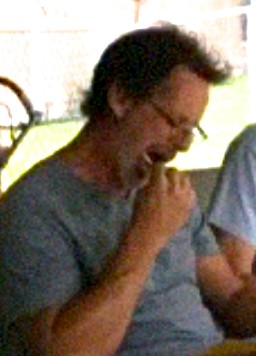 The
DNA test is non-intrusive. All that is involved is a swab from the inside of your cheek. John
has already processed his DNA kit and got his results, which includes a personalized certificate
prepared by a researcher from Hungary. The
DNA test is non-intrusive. All that is involved is a swab from the inside of your cheek. John
has already processed his DNA kit and got his results, which includes a personalized certificate
prepared by a researcher from Hungary.
John became very interested in his family roots this past summer when he was on a work-study
program from Moravian College, which he attends. He worked on a German farm for five weeks,
where he immersed himself in the language while studying agricultural and sustainability
practices. Taking advantage of his proximity to Burgenland, John also visited relatives in
Glasing (a town near Güssing), where he was greeted with open arms and lots of delicious
Austrian cooking.
John is scheduled to graduate with a degree in Secondary Education in English and German studies
this coming year. He would love to teach German (or English in Austria). He feels that this will
bring him closer to his ancestral roots.
Anyone interested in the Burgenland DNA Study project should contact Frank Paukowits at
paukowits1@aol.com for details. “We’re
always looking for new participants,” says Frank. There are 130 participants at this time.
|
6) HISTORICAL BB NEWSLETTER ARTICLES
Editor: This is part of our series designed to recycle interesting articles from the
BB Newsletters of 10 years ago. We do this, of course, because we continue to attract new
members to the BB, who likely have not read these old articles (they are in our Archive section)
and because the articles are simply worth reprinting again (as some of us older members may
have forgotten their content!).
I chose the article for this month because it touches on a topic discussed last month in Article
2; that topic being the need (or not) for a Passport to emigrate from Hungary in the 1800s. It
also touches on the requirements needed to qualify to emigrate.

THE BURGENLAND BUNCH NEWS No. 134C
November 30, 2004
BREITENBRUNN (from Albert Schuch)
In response to a query concerning this village Albert Schuch writes: Dujmovits'
book does not list any immigrant names for Breitenbrunn. As in the exhibition catalog "nach
Amerika", the chart entry is for 1854 without any names.
The main text however says (on page 119, Das Gebiet [region] um den Neusiedlersee):
"In Breitenbrunn sollen die ersten Amerikawanderer erst im Jahr 1907 den Ort verlassen haben
..." (the first immigrant came from here in 1907)
The source for the earlier Breitenbrunn data appears to be an article published by Hans Paul. I
am attaching a translated summary of this article (was published in BB newsletter 34) below.
Emigration period 1851-55: Some time ago, Hans PAUL, retired teacher and
Burgenland historian, found material on early emigrants in the Györ-Sopron Archives (Györ-Sopronmegyei
Levéltar) in Sopron:
On 9 Aug 1850 Franz PAYER of Balf (Wolfs, near Sopron), Hungary, 26 y old son of the
Lutheran pastor, wrote to the k.k. Bezirkskommissariat in Sopron (Ödenburg) for
permission to emigrate to America, where his brother already owned a farm with 160 acres land.
The k.k. (kaiserlich-königliches Bezirkskommissariat) gave the permission,
because: Franz P. has already served in the army; his home village, Wolfs, has no objections;
his father has no objections -- on the contrary, will provide financial support; he has two
younger brothers, so in case the army would need soldiers in the future, one of them could
replace him. Based on this information the k.k. Distriktsregierung (district
government) in Sopron gave permission to emigrate and provided Franz P. with an emigration
passport.
From 1851 onwards (until ????), those who wish to emigrate had to appear in person at the
k.k. Regierungskommissariat in Sopron, where they have to prove their ability to cover the
emigration costs by themselves. (Ship passage cost Bremen - New York in 1855: 65 silver
florins per person, children younger than 10 years pay 57 silver florins, babies younger than
one year pay nothing). Before they receive the emigration passport, they have to renounce
Austrian citizenship as well as the right to return to Austria.
In spring 1855 Johann MARILITSCH, 43 year old bricklayer from Großhöflein, asks for and
gets permission to emigrate to America. He is married and has 8 children (aged 5 - 17 years,
partly from earlier marriages of the couple, so some have the surname ROSENITSCH).
In March 1852 Franz WALTER, watchmaker from Eisenstadt asks for permission to emigrate
with his wife, 1 year old foster-child Samuel FRIEBE and 11 year old adopted child Elisabeth
KOPF. His parents and his brothers and sisters have emigrated in 1851. In September 1852
Magdalena KISS from Eisenstadt asks for permission to emigrate to New York. She wants
to marry a cabinetmaker from Vienna who has settled there.
Emigrants from Purbach: in 1854: Josef TURKOVITS (1854); in 1855: Franz SCHWARZ;
Michael HACKSTOCK, 56 years, his wife Elisabeth, 46 years, son Franz, 20, daughter Maria, 10;
Paul SCHÜLLER, 33 years, his wife Maria, 30, and their daughter Theresia, 3 years; Paul HUBER,
39 years, his wife (36 y), and 7 children aged 1 - 17 years; Stefan SANDHOFER, 44, his wife
Johanna, 41, children Paul (19), Franz (4) and Maria (1).
Emigrants from Breitenbrunn in 1855: Josef RESCH, 57 years, his wife Elisabeth, 40
years, their 10 children (3 - 21 years), and one grandchild; Anton HÄNDLER, 26 years, his wife
Theresia, 30, and their 3 children (2-6 years); Gregor JANISCH, his wife Kunigunde and their 5
children (5-20 years).
Further emigrants in 1855: Matthias STROMER, weaver from Schwendgraben; Josef
BAUER from Eisenstadt, 34 years, with wife Veronika; Josef HAIDER from Walbersdorf
(his 53 years old brother is already living in America, where he owns 2 houses, 160 Joch
farming land and 80 Joch forests; his brother has no heirs), 40 years old; Andreas PILLER,
bricklayer from Großhöflein, 14 year old son Franz and 10 year old daughter Theresia;
Paul REINER from Purbach, his wife and two children (his brother already in America).
(Source: Hans PAUL: Frühe Amerikawanderer unserer Heimat. In:
Burgenländische Forschungen. Sonderheft VI. (Festschrift für Karl SEMMELWEIS). Eisenstadt
1981, p.133-151)
|
7) ETHNIC EVENTS
LEHIGH VALLEY, PA
Nov. 20 - Dec. 21: Christkindlmarkt in Bethlehem. Info:
www.christmascity.org/christkindlmarkt
Nov. 21 - Dec. 23: Weihnachtsmarkt in Bethlehem. Info:
www.downtownbethlehemassociation.com/events/christmas-city-village
Tuesday, Dec. 2: German-English Advent Singstunde at Central Moravian Church in
Bethlehem. Info: www.centralmoravianchurch.org
Saturday, Dec. 6: Christkindlnacht at the Evergreen Heimatbund in Fleetwood. Info:
www.evergreenclub.org
Saturday, Dec. 6: Christmas Concert & Dance at the Lancaster Liederkranz. Music by
the Lancaster Liederkranz Chorus and the Joe Weber Orchestra. Info:
www.lancasterliederkranz.com
Sunday, Dec. 7: Christkindlmarkt at the Reading Liederkranz. Info:
www.readingliederkranz.com
Sunday, Dec. 7: Christmas Dance at the Holy Family Club in Nazareth. Music by the
Walt Groller Orchestra. Info:
www.holyfamilyclub.com
Saturday, Dec. 13: Christmas Concert & Dance at the Coplay Sängerbund. Music by
the Coplay Sängerbund Chorus and the Joe Weber Orchestra. Info:
www.coplaysaengerbund.com
Saturday and Sunday, Dec. 27-28: "Die Fledermaus" at the Reading Liederkranz.
Performed by the Berks Opera Company. Info:
www.readingliederkranz.com
Wednesday, Dec.31: Silvesterball at the Reading Liederkranz. Music by the Walt
Groller Orchestra. Info:
www.readingliederkranz.com
Wednesday, Dec. 31: New Year's Eve at the Lancaster Liederkranz. Music by the
Maria and John Quartet. Info:
www.lancasterkiederkranz.com
Wednesday, Dec. 31: New Year's Eve at the Evergreen Heimatbund in Fleetwood. Music
by the Josef Kroboth Orchestra. Info:
www.evergreenclub.org
Wednesday, Dec. 31: New Year's Eve at the Coplay Sängerbund. Info:
www.coplaysaengerbund.com
NEW BRITAIN, CT
Friday, December 5, 7 pm: Heimat Abend. Austrian Donau Club, 545 Arch Street, $3.
Music by Joe Rogers and his band.
Friday, December 19, 7:30 pm: Heurigan Abend. Austrian Donau Club, 545 Arch
Street, $3. Music by Schachtelgebirger Musikanten.
|
8) BURGENLAND EMIGRANT OBITUARIES
Anne Fleming (née Kullowitsch)
 Anne
A. Fleming, 90, passed away on Thursday, Nov. 13, 2014 in Arlington Heights. Anne
A. Fleming, 90, passed away on Thursday, Nov. 13, 2014 in Arlington Heights.
The daughter of the late George and Anna (Reicher) Kullowitsch, she was born Jan. 3, 1924 in
Kleinpetersdorf, Austria and had lived in several communities, including Chicago, Hoffman
Estates, Vernon Hills and Gurnee and also enjoyed a time of retirement in Brooksville, FL.
Surviving are 8 children, Raymond (Phyllis) Fleming, Barbara (Michael) Carney, Peter (Colleen)
Fleming, Kevin (Anne) Fleming, Dr. Maureen Fleming, Gregory (Beth) Fleming, Laura Sherwood and
Tim (Mary) Fleming; 17 Grandchildren, 14 Great Grandchildren and her sister, Sr. Martinus
Kullowitsch. She was preceded in death by her husband Raymond in 1994.
Mass of Christian Burial will be held at 11 a.m. Tuesday, Nov. 18, at St. Mary of Vernon
Catholic Church, 236 W. Hwy. 45, Indian Creek. Visitation will be for one hour prior to the mass
at church. Interment will follow at St. Michael the Archangel Cemetery, Palatine. Memorial
contributions can be made to either St. Mary of Vernon Church or to Midwest Palliative and
Hospice Care Center. Arrangements are by the Burnett-Dane Funeral Home in Libertyville. Info:
847-362-3009 or please sign the guest book at www.burnettdane.com.
Published in Chicago Suburban Daily Herald on Nov. 17, 2014.

John Jelosits
 John
Jelosits, 86, of Whitehall, Pennsylvania, passed away November 24, 2014 at home. John
Jelosits, 86, of Whitehall, Pennsylvania, passed away November 24, 2014 at home.
Born in Coplay, Pennsylvania and raised in Reinersdorf, Austria, he was a son of the late Johann
and Paulina (Sorger) Jelosits.
He was the loving husband of Anna (Fischl) Jelosits. They celebrated their 56th wedding
anniversary on November 22, 2014.
John was a member of St. Elizabeth of Hungary Catholic Church, Whitehall. He was employed by
Roche Chemicals and lived in Fairfield, NJ. both for 30 years, retiring in 1990. He enjoyed his
talent of wood working as a hobby.
Survivors: Wife; son; James E. and his wife Marita of New Jersey; brothers, Joe and his wife
Marie of Connecticut, Franz and wife Anna in Austria; sister, Hela Sommer in Austria;
sister-in-law, Hilda of Bronx, NY; grandson, Troy and a granddaughter, Lindsey; nieces and
nephews. John was predeceased by a brother; Willie.
Services: Viewing: 9:00am - 10:00am Saturday, November 29, 2014 followed by a mass of Christian
burial at 10:00am, all in St. Elizabeth Catholic Church 619 Fullerton Ave. Whitehall, PA.
Entombment will be in Grandview Cemetery Mausoleum. (www.weberfuneralhomes.com).
Published in Morning Call on Nov. 27, 2014 
Juliana Wolf (née Eichner)
 Juliana
Wolf, 85, of Allentown, Pennsylvania, passed away on November 25, 2014. Juliana
Wolf, 85, of Allentown, Pennsylvania, passed away on November 25, 2014.
She was the wife of the late Robert J. Wolf, who died in 1994.
Born in Rudersdorf, Austria on May 17, 1929, she was a daughter of the late Johann and Karolina
(Flasch) Eichner.
Survivors: Sons, Gary and wife Loretta, and granddaughter Liesl, and Michael and grandson Jacob.
She was predeceased by 10 brothers and sisters.
Services: Viewing Monday, December 1, 10am till time of service at 11am. Both at Weber Funeral
Home, 1619 W. Hamilton St., Allentown. Interment to follow at Cedar Hill Memorial Park,
Allentown. www.weberfuneralhomes.com.
Published in Morning Call on Nov. 28, 2014
|
END OF NEWSLETTER
|
NOTICE (Terms and Conditions): The Burgenland Bunch (BB) was formed and exists to assist
Burgenland descendants in their research into their heritage and, toward that end, reserves the
right to use any communication you have with us (email, letter, phone conversation, etc.) as
part of our information exchange and educational research efforts.
• If you do not want your communication to be used for this purpose, indicate that it is
"confidential" and we will abide by that request.
• Correspondents who communicate with the BB without requesting confidentiality retain their
copyright but give a non-exclusive license to the BB allowing us to forward to BB members,
publish in our monthly newsletter or on our website, and/or subsequently and permanently archive
all or parts of such communications.
The Burgenland Bunch homepage (website) can be found at:
http://www.the-burgenland-bunch.org
Burgenland Bunch Newsletter, copyright © 2014 by The Burgenland Bunch
All rights reserved. Permission to copy excerpts granted if credit is provided. |
 Concerning
this newsletter, after the bits and pieces here in my "Corner," our first full-length article,
Article 2, responds to (and expands on) a question concerning whether a particular village was
in Cisleitha Versus Transleitha. That labeling distinction affected far more than
just the Burgenland region!
Concerning
this newsletter, after the bits and pieces here in my "Corner," our first full-length article,
Article 2, responds to (and expands on) a question concerning whether a particular village was
in Cisleitha Versus Transleitha. That labeling distinction affected far more than
just the Burgenland region!

 Cisleithania (Empire of Austria): 1. Bohemia [Czech Republic], 2.
Bukovina [Romania, Ukraine], 3. Carinthia [Austria, Italy, Slovenia], 4. Carniola [Slovenia], 5.
Dalmatia [Croatia], 6. Galicia [Poland, Ukraine], 7. Küstenland [Croatia, Italy, Slovenia], 8.
Lower Austria [Austria, Czech Republic], 9. Moravia [Czech Republic], 10. Salzburg [Austria],
11. Silesia [Czech Republic, Poland], 12. Styria [Austria, Slovenia], 13. Tyrol [Austria,
Italy], 14. Upper Austria [Austria], 15. Vorarlberg [Austria];
Cisleithania (Empire of Austria): 1. Bohemia [Czech Republic], 2.
Bukovina [Romania, Ukraine], 3. Carinthia [Austria, Italy, Slovenia], 4. Carniola [Slovenia], 5.
Dalmatia [Croatia], 6. Galicia [Poland, Ukraine], 7. Küstenland [Croatia, Italy, Slovenia], 8.
Lower Austria [Austria, Czech Republic], 9. Moravia [Czech Republic], 10. Salzburg [Austria],
11. Silesia [Czech Republic, Poland], 12. Styria [Austria, Slovenia], 13. Tyrol [Austria,
Italy], 14. Upper Austria [Austria], 15. Vorarlberg [Austria];
 BB
member Kevin Krizman, currently of Umkirch, Germany, wrote to say (in part): Hi Tom,
just a quick note to let you know we lost one of our own this month. My uncle, Ray Bubick, 81,
died peacefully (if unexpectedly) at home on Oct 12, 2014. His obituary is here:
obituary/Raymond-Joseph-Bubick/Highlands-Ranch-CO. Ray was a great fan of the Burgenland
Bunch [Ed: ...and a long-time member; the earliest note from Ray I found in the newsletters
dates from July 2003, wherein he commented on a goulash recipe, noted a 2002 trip to Burgenland
and his 12 first cousins there, and invited BB members to stop by in Denver to share some
goulash!]. He dutifully and enthusiastically forwarded the newsletter to members of the
family every month (even to those of us with a separate subscription :-)). I know Ray
appreciated and enjoyed being involved with the Burgenland group; he was responsible for
infecting me with enthusiasm for Burgenland as well.
BB
member Kevin Krizman, currently of Umkirch, Germany, wrote to say (in part): Hi Tom,
just a quick note to let you know we lost one of our own this month. My uncle, Ray Bubick, 81,
died peacefully (if unexpectedly) at home on Oct 12, 2014. His obituary is here:
obituary/Raymond-Joseph-Bubick/Highlands-Ranch-CO. Ray was a great fan of the Burgenland
Bunch [Ed: ...and a long-time member; the earliest note from Ray I found in the newsletters
dates from July 2003, wherein he commented on a goulash recipe, noted a 2002 trip to Burgenland
and his 12 first cousins there, and invited BB members to stop by in Denver to share some
goulash!]. He dutifully and enthusiastically forwarded the newsletter to members of the
family every month (even to those of us with a separate subscription :-)). I know Ray
appreciated and enjoyed being involved with the Burgenland group; he was responsible for
infecting me with enthusiasm for Burgenland as well. As
a young boy growing up in Northern Indiana, I often wondered about my ancestors, my heritage,
and in particular, my grandparents. All my friends and pals had grandparents, so I often asked,
why didn't I? I envied my pals; their doting grandparents always seemed to have presents for
them, always seemed to have "hugs," and always acted as surrogate parents!
As
a young boy growing up in Northern Indiana, I often wondered about my ancestors, my heritage,
and in particular, my grandparents. All my friends and pals had grandparents, so I often asked,
why didn't I? I envied my pals; their doting grandparents always seemed to have presents for
them, always seemed to have "hugs," and always acted as surrogate parents!  The
DNA test is non-intrusive. All that is involved is a swab from the inside of your cheek. John
has already processed his DNA kit and got his results, which includes a personalized certificate
prepared by a researcher from Hungary.
The
DNA test is non-intrusive. All that is involved is a swab from the inside of your cheek. John
has already processed his DNA kit and got his results, which includes a personalized certificate
prepared by a researcher from Hungary. Anne
A. Fleming, 90, passed away on Thursday, Nov. 13, 2014 in Arlington Heights.
Anne
A. Fleming, 90, passed away on Thursday, Nov. 13, 2014 in Arlington Heights. John
Jelosits, 86, of Whitehall, Pennsylvania, passed away November 24, 2014 at home.
John
Jelosits, 86, of Whitehall, Pennsylvania, passed away November 24, 2014 at home. News
News "It
has been a while since the St. Louis contingent of Burgenländers got together, but they did
just that on November 2nd. Around 25 folks showed up, some who are members of the BB, others
who heard about the gathering by word of mouth and through church bulletins. It was a
wonderful afternoon of making connections with fellow Burgenland descendants. There was food -
Austrian, Hungarian, American, German, and liquid refreshments from the Burgenland vineyards.
People brought old photos of unknowns that some others were able to identify. Some discovered
the BB and various websites that will help them with their ancestry searches. Several of the
folks already had connections outside of their heritage and discovered this one for the first
time. It was a most enjoyable gathering and we look forward to future events!"
"It
has been a while since the St. Louis contingent of Burgenländers got together, but they did
just that on November 2nd. Around 25 folks showed up, some who are members of the BB, others
who heard about the gathering by word of mouth and through church bulletins. It was a
wonderful afternoon of making connections with fellow Burgenland descendants. There was food -
Austrian, Hungarian, American, German, and liquid refreshments from the Burgenland vineyards.
People brought old photos of unknowns that some others were able to identify. Some discovered
the BB and various websites that will help them with their ancestry searches. Several of the
folks already had connections outside of their heritage and discovered this one for the first
time. It was a most enjoyable gathering and we look forward to future events!"

 Update
on book "The Burgenländer Emigration to America": As I will do for a while, here is this
month's update on purchases of the English issue of the 3rd edition of Dr. Walter Dujmovits'
book “Die Amerika-Wanderung Der Burgenländer.”
Update
on book "The Burgenländer Emigration to America": As I will do for a while, here is this
month's update on purchases of the English issue of the 3rd edition of Dr. Walter Dujmovits'
book “Die Amerika-Wanderung Der Burgenländer.”  5½
c. flour
2 packages of dry yeast
5½
c. flour
2 packages of dry yeast


 [Ed:
Maria Francisca, b 1895, d 1897] born to my grandparents, who never survived; although the
accuracy of this is in question. I'm not sure when my father arrived in the U.S., but I believe
it was in 1924 [Ed: he left Rotterdam on 16 Jan 1924 and arrived in NYC on 27 Jan 1924 on the
SS Rotterdam; going to Chicago to join uncle Anton Blazowitsch]. So, my guess is that he was
near 20 years old when he arrived.
[Ed:
Maria Francisca, b 1895, d 1897] born to my grandparents, who never survived; although the
accuracy of this is in question. I'm not sure when my father arrived in the U.S., but I believe
it was in 1924 [Ed: he left Rotterdam on 16 Jan 1924 and arrived in NYC on 27 Jan 1924 on the
SS Rotterdam; going to Chicago to join uncle Anton Blazowitsch]. So, my guess is that he was
near 20 years old when he arrived. As
with all immigrants who entered the US, they processed through the central processing facility
on Ellis Island. I'm sure their names (as well as that of my father) are recorded somewhere in
the archives of Ellis Island.
As
with all immigrants who entered the US, they processed through the central processing facility
on Ellis Island. I'm sure their names (as well as that of my father) are recorded somewhere in
the archives of Ellis Island.  Strange
as it seems, my father and mother did not know each other in Burgenland, even though they were
reared in villages not more than a few miles apart. They did not meet until they did so in South
Bend. My father had been married before he married my mother. He was married to a woman named
Agnes, who died rather suddenly in 1929 and left my father as a widower with my half sister
Lillian [Ed: Lillian was mother to Kevin Krizman, who shared Ray's memoir with us].
Lillian was seven years older than I. There is a little mystery (if that's the right word)
behind Agnes' death—not that she was mysteriously murdered or anything like that—but, from my
Aunt Emma, I got the impression that Agnes committed suicide. Anyway, my father and mother met
in South Bend sometime in 1931 and were married in February 1932.
Strange
as it seems, my father and mother did not know each other in Burgenland, even though they were
reared in villages not more than a few miles apart. They did not meet until they did so in South
Bend. My father had been married before he married my mother. He was married to a woman named
Agnes, who died rather suddenly in 1929 and left my father as a widower with my half sister
Lillian [Ed: Lillian was mother to Kevin Krizman, who shared Ray's memoir with us].
Lillian was seven years older than I. There is a little mystery (if that's the right word)
behind Agnes' death—not that she was mysteriously murdered or anything like that—but, from my
Aunt Emma, I got the impression that Agnes committed suicide. Anyway, my father and mother met
in South Bend sometime in 1931 and were married in February 1932.